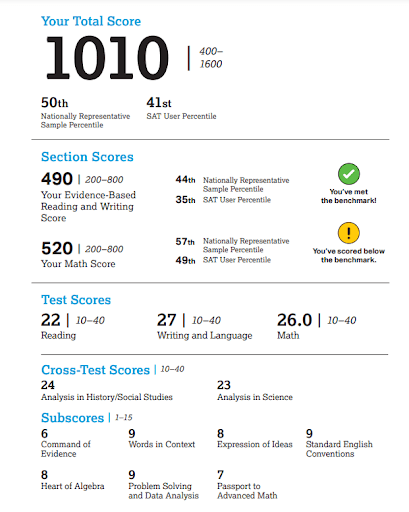
Understanding the SAT Score Range for Academic Success
Do you often find yourself wondering, “What exactly is my SAT score range, and what does it mean?” If so, you’re not alone.
The SAT score range, a jumble of numbers and percentiles, often leaves aspiring college applicants scratching their heads. But fear not, for this blog post is here to shed light on this often misunderstood concept of the SAT score range and help you understand what your various scores mean on the report.
What is the Total SAT Score Range?
When you receive your SAT score report, your eyes are immediately drawn to the big number at the top—your total score. This number, ranging from 400 to 1600, represents your combined performance in the Evidence-Based Reading, and Writing, and Math sections. But wait, there’s more to your score than meets the eye.
Just below your total score, you’ll find a smaller number in parentheses, known as your score range. This score range indicates the possible scores you might have gotten if you had taken the SAT multiple times under identical conditions. This variability is common and doesn’t diminish your overall achievement. It’s like a little secret window into your academic consistency.
Why is the score range important? Well, it reflects the natural variation in performance that even the best test-takers experience. Colleges understand this, and some even consider your score range along with your total score when evaluating your application. They appreciate this holistic approach, allowing your true potential to shine through.

What Do You Mean by Section Score Range in the SAT?
Each section of the SAT exam, Reading and Writing and Math, is scored on a scale of 200 to 800 points.
In the paper-based version, the Reading and Writing score combines the scores for the Reading Test and the Writing and Language Test.
The Math score is based on the Math Test, which includes both calculator-allowed and calculator-free sections.
What is the Additional Score Range on the SAT?
Test Scores
Your SAT scores for Reading, Writing, Language, and Math fall within a range of 10 to 40 points.
This part of your score report compares your performance to benchmarks for college readiness, indicating whether you’re on track, almost on track, or need improvement. The score report also shows you the number of questions you answered correctly and incorrectly.
Cross-Test Scores
The cross-test score range is also between 10 and 40. These scores reflect your performance on selected questions across the three tests, highlighting your strengths in the following areas:
- Analysis in History/Social Studies
- Analysis in Science
Subscores
The SAT also provides subscores, which range from 1 to 15. These subscores offer feedback on your performance in specific skill areas.
These skill areas include:
- Command of Evidence
- Words in Context
- Expression of Ideas
- Standard English Conventions
- Heart of Algebra
- Problem Solving and Data Analysis
- Passport to Advanced Math
SAT Essay Scores
You must be aware that the SAT Essay is only available in states where it’s required as part of SAT School Day administrations since early 2021. However, you must know the score range. It is scored on a scale of 2 to 8 in three categories:
- Reading
- Analysis
- Writing.
Note: These scores are not added together or combined with any other SAT scores.
Your online scores will show the prompt that you responded to and your essay. This allows you to see how you did on each of the three scoring dimensions.
Suggested: When Do SAT Scores Come Out
What Do You Mean by a Student’s Score on the SAT?
When it comes to evaluating student performance, relying solely on pinpoint scores can be misleading. Instead, score ranges offer a more comprehensive and realistic representation of a student’s abilities. These ranges are derived from the standard error of measurement, a statistical measure that quantifies the inherent variability in test scores. In simpler terms, score ranges indicate how much a student’s score might fluctuate if they took the same test multiple times under identical conditions.
For the SAT, the standard error of measurement varies depending on the type of score:
- Total Score: ±40 points
- Section Score (Math or Evidence-Based Reading and Writing): ±30 points
- Test Score, Subscore, or Cross-Test Score (for paper-based SAT only): ±2 points
In simpler terms, if a student scores 500 on the Math section, their true score could be anywhere between 470 and 530. This variability doesn’t mean the test is inaccurate; it simply reflects the fact that students’ performance can fluctuate due to factors like test anxiety or varying levels of preparation.
To get a better grasp of the SAT score range, we’ve provided a sample SAT score report for your reference. Take a look at the sample report to understand what the SAT score range encompasses.
An Example of an SAT Score Report

Source: College Board
As you can see, the SAT score range is not just a single number. It’s a band of scores that reflects the variability in your performance on the test.
Understanding score ranges provides a more holistic perspective on student performance, moving away from rigid numerical representations and embracing the inherent variability of human performance. By acknowledging this variability, colleges can make more informed decisions about student placement, academic interventions, and college admissions.
Suggested: What is a Good SAT Score?
From the Desk of Yocket
The SAT score range is a broad spectrum that encompasses a wide range of academic abilities. The SAT score range is a valuable tool for understanding your performance on the SAT and for making strategic decisions about college admissions. By using the SAT score range effectively, you can increase your chances of getting into the colleges you are most interested in attending.
While there is no single “good” or “bad” SAT score, the range can provide valuable insights into a student’s preparedness for college-level coursework.
Experienced college admissions counselors and educators emphasize the importance of considering the SAT score range in conjunction with other factors, such as GPA, extracurricular activities, letters of recommendation, and personal essays. They stress that a high SAT score does not guarantee admission, nor does a lower score preclude acceptance.
One expert, a former admissions director at a selective university, highlights the role of the SAT score range in context. “The SAT score range serves as a benchmark for colleges to evaluate applicants with a similar academic background,” they explain. “A higher score within the range indicates stronger academic performance and may enhance an applicant’s profile.”
Another expert, a renowned college admissions consultant, emphasizes the importance of understanding the SAT score range for specific colleges. “Each college has its own average SAT score range, which reflects the academic profile of its admitted students,” they advise. “By researching the SAT score range of their target colleges, students can assess their competitiveness and make informed decisions about their applications.”
According to experts, it’s advised for students to target scores within the middle 50% range of their desired colleges to improve admission prospects. Yocket specialists also advise students to assess their complete academic profile and involvement in extracurricular activities, as these elements significantly impact holistic admissions decisions.
Frequently Asked Questions
1. What is the SAT percentile?
An SAT percentile is a measure of how well you did on the SAT compared to other students who took the test. It tells you what percentage of students scored lower than you on the test. For example, if you score in the 90th percentile, this means that you scored higher than 90% of all students who took the SAT.
2. What is the average SAT score?
According to a report from the College Board, the average SAT score for the high school class of 2022 in the United States was 1050, down by 10 points from the class of 2021. This means that half of all students who take the SAT score 1051 or higher, and the other half score 1050 or lower.
3. What are the highest and lowest SAT score ranges?
The highest possible SAT score is 1600, and the lowest possible SAT score is 400.
